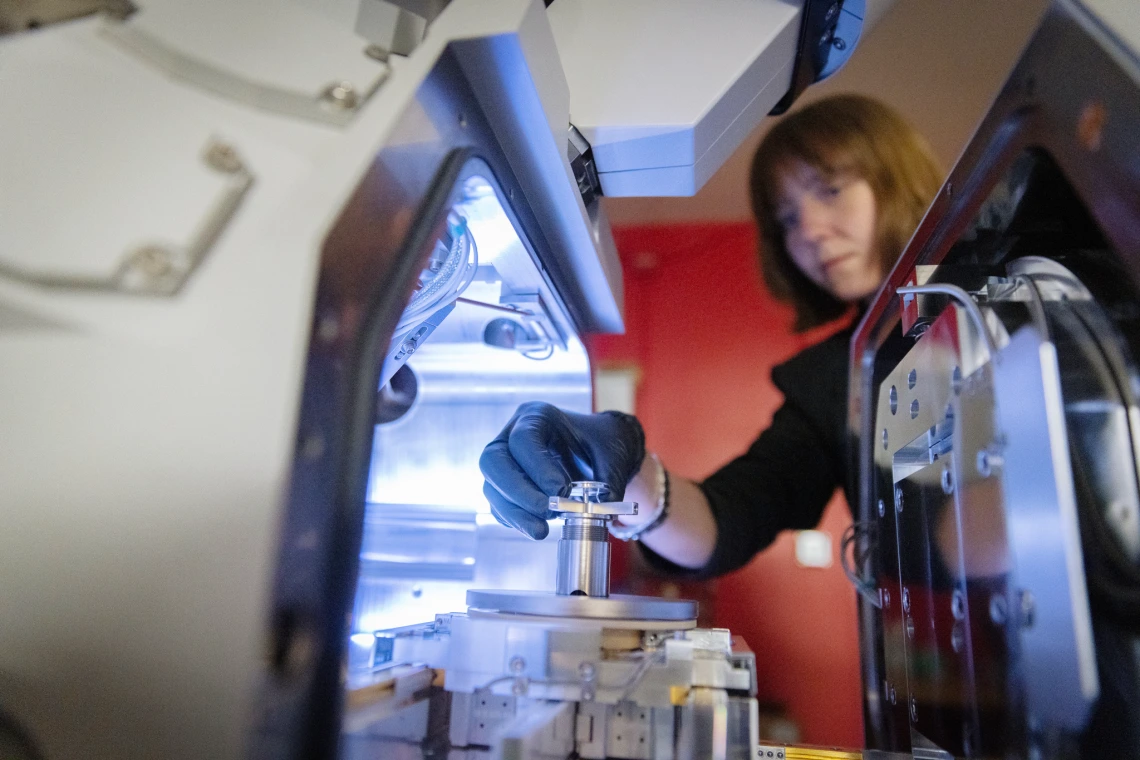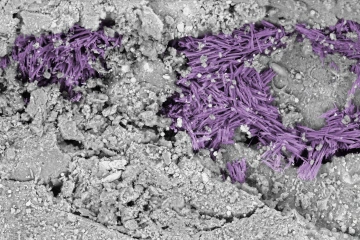What Bennu Brought
Asteroid Bennu comes from a long-lost world bearing ingredients for life.

Zoe Zeszut, lab manager and research scientist at the University of Arizona Kuiper-Arizona Laboratory for Astromaterials Analysis, prepares a vial containing extraterrestrial sample material for analysis.
Chris Richards
The solar system had the conditions to “cook up” the chemical precursor ingredients for life before Earth formed, according to two studies published by the sample analysis team of NASA’s OSIRIS-REx mission led by Dante Lauretta ’93 at the University of Arizona.
The OSIRIS-REx spacecraft returned a sample from asteroid Bennu in 2023. Following a year of in-depth analyses in labs across the globe, researchers concluded that these conditions and ingredients may have been common across the solar system, increasing the odds of life forming on other planets and moons.
“These samples from Bennu are an incredible discovery, showing that the building blocks of life were widespread across the early solar system,” says Lauretta, Regents Professor of planetary science and cosmochemistry at the U of A’s Lunar and Planetary Laboratory, and a coauthor on both papers.
“By studying how these ingredients interacted in environments like those on Bennu and in places inferred for the early Earth — such as salty ponds similar to those Darwin once imagined — we can better understand how life might emerge and where to search for it beyond our planet.”
Bennu coalesced from a small portion of the rubble left over from a giant collision of asteroids. Preserved in the vacuum of space since the solar system’s formation about 4.5 billion years ago, the samples have provided scientists with unparalleled insights into the conditions of that era.
Based on their findings, published in Nature and Nature Astronomy, the researchers share several theories about the history of Bennu and the solar system.

In this microscope image of a Bennu sample, needles of hydrated sodium carbonate, a salt left by evaporating brine, appear in purple false color. Had these salts been exposed to water in Earth’s atmosphere, as would be the case with a meteorite, they could easily have been compromised, underscoring the value of sample return missions like OSIRIS-REx.
Rob Wardell/Tim McCoy/Smithsonian Institution; colorization: Heather Roper/University of Arizona
Bennu’s molecular composition suggests the ice and organic compounds in its parent body originated in the extremely cold outermost disk of gas and dust that gave rise to the solar system.
Temperatures in the outer disk could dip to minus 400 degrees Fahrenheit, allowing volatile gases that easily evaporate in warmer conditions to accumulate and freeze — among them water vapor, carbon dioxide, methane and ammonia, which was detected in “exceptionally high” levels in the Bennu samples, according to the Nature Astronomy paper.
In the right environment, ammonia can react with formaldehyde, which was also detected in the samples, to form complex molecules such as amino acids — the building blocks of proteins. Fourteen of the 20 amino acids that life on Earth uses to make proteins are found in the Bennu sample. The research team also found all five nucleobases that life on Earth uses to encode structural information in more complex biomolecules like DNA and RNA.
“Besides pointing to the outer solar system origin of abundant ammonia in Bennu’s ancestor, our work also supports the idea that objects that formed far from the sun could have been an important source of the raw ingredients for life throughout the solar system,” says Danny Glavin, the senior scientist for sample return at NASA’s Goddard Space Flight Center in Greenbelt, Maryland. Glavin, together with colleague Jason Dworkin, led the paper in Nature Astronomy.
With life’s ingredients found in the Bennu samples, the big question is: How did these building blocks turn into the chains of molecules needed to activate biology?
“You can have all the ingredients for whatever you want to make, but you have to have the environment to make them do something,” says Tim McCoy, curator of meteorites at the Smithsonian National Museum of Natural History in Washington, D.C.
Along with Sara Russell of the Natural History Museum in London, McCoy co-led 66 scientists from four continents in a study of minerals in the Bennu samples. In the Nature paper, they describe evidence of an ancient environment well suited to kickstart the chemistry of life.
Ranging from calcite to halite and sylvite, scientists identified 11 minerals that make up a complete set of “evaporites” from a brine, or salt-saturated water. These evaporites form as water containing dissolved salts evaporates over long periods, leaving behind the salts as solid crystals.
“We’re seeing minerals in Bennu samples that we have never seen before in a meteorite or any extraterrestrial sample,” McCoy says.
Finding evaporites indicates that the interior of Bennu’s ancestor was warm enough to support liquid water for a substantial period. Liquid water is necessary for life, as it facilitates its essential chemical reactions, while salts can prevent water from freezing. Salts also help concentrate simple molecules, making it easier for them to combine into the complex compounds life depends on.
While several evaporites have been reported from meteorite samples, the Bennu sample represents the first time researchers have seen a complete set preserving an evaporation process that could have lasted thousands of years or more. This process happens in basins of water on Earth, including drying lakes and shallow seas. The researchers deem it possible that on Bennu’s ancestor, water could have existed in underground pockets or veins, but not on the surface, as it would have quickly boiled away due to lack of atmospheric pressure.
